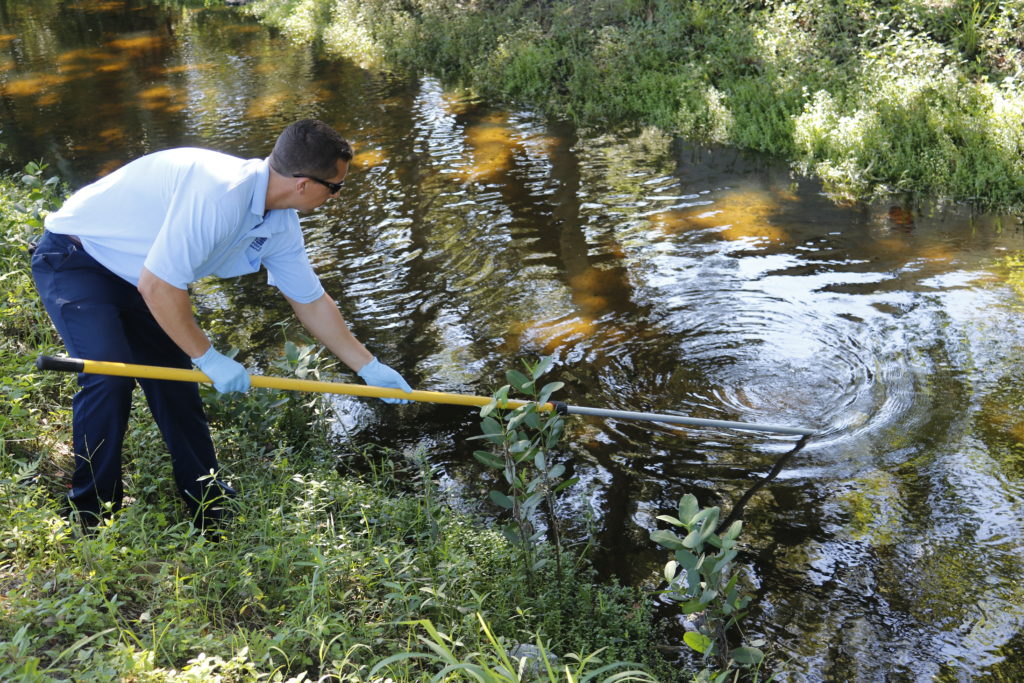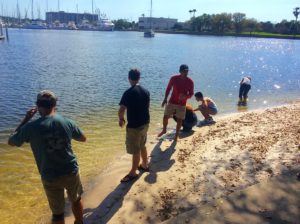By Devin Rodriguez drodriguez7@mail.usf.edu
and Michael Moore Jr. michaelmoor@mail.usf.edu
For 10 straight days, wastewater was dumped into Tampa Bay, less than a mile from the waterfront campus of USF St. Petersburg.
Torrential rains that accompanied Hurricane Hermine overwhelmed St. Petersburg’s outdated sewage treatment facilities, forcing the city to dump millions of gallons of untreated and partially treated sewage from its plant at Albert Whitted Airport into a pipe that ended in the bay a quarter mile off the downtown shoreline.
The dumping finally ended on Sept. 9. But the environmental and political fallout have just begun.
What impact will there be on the quality of the water in Bayboro Harbor?
What will happen to the birds and marine life that depend on the bay?
And perhaps most important, could this happen again?
Dr. Robert Weisberg, an experimental physical oceanographer and professor in the USFSP College of Marine Science, predicted that it will.

bacteria and high levels of nutrients. Here, Gagnon samples a canal connected to Clam Bayou, just outside of Gulfport.
The city has an infrastructure problem, he said. Its four sewage treatment plants have a maximum capacity. When they are overwhelmed by heavy rain and flooding, he said, the city will be forced to dump the excess.
“A lot of people have immediately blamed the wastewater treatment plants,” said Dr. Monica Cook, an instructor in marine science. “But they (the plants) can only deal with what they’re designed to deal with. They have a maximum capacity.”
St. Petersburg was not the only government agency that experienced a sewage treatment crisis when Hermine brushed past as a tropical storm-turned-hurricane.
Pasco County, Clearwater, Largo, Pinellas County and Tampa were also forced to dump excess wastewater.
On Tuesday, Pinellas County legislators will discuss the issue at a workshop in the Karen A. Steidinger Auditorium in the Fish and Wildlife Research Institute on the USFSP campus. The meeting begins at 3 p.m.
The St. Petersburg City Council, which will discuss the issue again Thursday, is now scheduled to spend $58 million next year and $100 million over three years upgrading its underground pipes and increasing capacity at its processing plants.
Meanwhile, the Department of Environmental Protection is preparing an order that would require the city to fix the system or face fines, according to the Tampa Bay Times.
USFSP’s campus recreation suspended waterfront activities Sept. 5-6. The waterfront department has not issued any official notice or warnings to students. Instead, campus rec employees have warned patrons, who are renting equipment, of the influx of sewage in the water.
Blame Game Won’t Help Things, He Says
Dr. Robert Weisberg doesn’t see much benefit in pointing fingers or looking for someone to blame.
Instead, he wants to know “how do we fix it?”
Weisberg said that tackling environmental issues of this magnitude requires a multidisciplinary approach. For him, understanding the role that ocean currents play in the draining of organic waste from an estuary such as Tampa Bay is essential to truly comprehending the problem.
Tampa Bay has been in a state of recovery for decades.
Weisberg recalled when the counties were regularly dumping little more than raw sewage into the water.
“In the ‘70s it was quite a dirty body of water,” Weisberg said. “The worst thing we can do is have these raw sewage dumps. They take us backward.”
Weisberg believes the dumping will continue, and cited the fundamental infrastructure problems as a likelihood of a repeat incident.
Dumping to cause numerous problems in the Bay
Dr. Monica Cook teaches at USF Tampa and St. Petersburg. She specializes in chemical contamination and studies the pharmaceutical by-product that ends up in the water.
Cook said that any amount of raw sewage, no matter how small, would hold consequences for the surrounding environment.
Sewage can bring in nutrients, chemicals and microorganisms to the water.
“Any amount of these greater than what exists already in the natural environment can have detrimental consequences,” Cook said. Excessive nutrients can lead to what scientists refer to as “harmful algal blooms.”
“The degradation of the bloom is very harmful to the environment because it uses up oxygen,” Cook explained.
This can lead to massive fish kills.
Chemicals pose significant risks to both the organisms that live within the environment and humans.
“When I talk about chemicals, I’m talking about pharmaceutical compounds such as antibiotics or synthetic compounds like microplastics,” Cook said.
Even treated sewage is not without its problems.
“These chemicals of emerging concern tend not be filtered out by wastewater treatment,” she said.
Microorganisms are bacteria, viruses, protozoa, eggs and more.
“Some of these can be pathogenic or disease-causing,” Cook said.
Clams, oysters, and other filter feeders can intake these microorganisms and store them in their tissues, making them potentially harmful for human consumption.
There is also growing public concern over Vibrio vulnificus, or flesh-eating bacteria, after warm temperatures in the Gulf of Mexico have allowed conditions for the bacteria to come into contact with humans.
“If you have a raw sewage dump, all of those things are now being introduced into the environment,” said Cook.
For Cook, correcting the problem starts with each of us.
“We have to educate ourselves. We need to learn what is appropriate to throw away, what is okay to be flushed. We have to learn the difference,” Cook said.
Sewage Dump Hinders Bayfront Learning
For Kathy Carvalho-Knighton, Bayboro Harbor is more than just a body of water.
“This water is my classroom,” said Carvalho-Knighton, an environmental policy and science professor.
Now, Carvalho-Knighton’s classroom is polluted with approximately 151 million gallons of sewage.
While she used to use Fort DeSoto Beach to teach students, Carvalho-Knighton has found that using the environment surrounding the university connected with Bulls more. She said that the bayfront view is part of what draws people to USFSP.
“This is a part of the university,” said Carvalho-Knighton. “It’s part of why I came to work for this campus.”
In the past, Carvalho-Knighton has shown her students how to test the water quality.
“I’ve taken my students to kayak down to Lassing Park multiple times,” she said.
At Lassing Park, the class collected water samples to test for E. coli, nitrates and the pH of the water. Students also learned how to identify aquatic plants and wildlife.
“This gives me an idea,” said Carvalho-Knighton. “I’ll have my students test the water next week before we go out in the kayaks.”
Chief Wastewater Plant Operator asks for whistleblower status
Craven R. Askew is the chief plant operator of the city’s Northeast wastewater treatment facility. On Friday, Askew sought whistleblower status after writing an 11-page letter to Mayor Rick Kriseman about the closing of the Albert Whitted facility.
Askew stated that city council members and key staffers knew that sewage spillage and dumps were possible if it closed that facility, whose burden was then directed towards the Southwest plant.
Since closing Albert Whitted in 2015, the city has dumped over 190 million gallons of sewage.
“[The] Albert Whitted plant needs to be placed back into service until [Southwest] completes the required upgrades for the sake of Public Health and Environmental impact of sewage spills,” Askew wrote.
“We are the stewards of our environment,” Askew said, later that Friday, during a tour of the Northeast Plant with the Crow’s Nest.
Askew explained that each of the four facilities serves the same purpose, to filter wastewater into reclaimed water, but all adhere to different parameters.
“Shutting down one of them hurt us,” said Askew. “We should use our money wisely but public safety comes first.”
The Northeast plant is the only wastewater facility that did not have to dump sewage after Hurricane Hermine.
City checks for contaminants
Zach Gagnon collects water samples across St. Petersburg every morning. He is an environmental specialist working for the city.
Gagnon works for the environmental compliance department. They collect water data to help city officials make decisions with regard to water treatment.
“We can’t be proactive in this department,” Gagnon said. “I mean we can only go in after the fact.”
Friday, Sept. 16, Gagnon is scheduled to visit the Northeast Wastewater Treatment facility.
Gagnon said that he enjoys his work.
“I really enjoy educating people about this stuff,” Gagnon said. “My friends call me the water guy.”
People call the Water Resource department asking about the drinking water, Gagnon said.
“The drinking water is a completely separate system,” said Gagnon. “The two have no overlap at all.”
Gagnon said that his department does a variety of tests on the water, but checks for fecal coliform, a bacteria found in mammal intestine, and high nitrates, an excess nutrient that helps produce algal blooms.
There is a certain amount of these byproducts that are in the water at any time, but with the influx of sewage, beaches and other water sources have been at risk of being closed to the public.
The city adheres to the Beaches Environmental Assessment Clean Water Act, which requires data to be sent to the Environmental Protection Agency to determine the health risk of surrounding beaches.
Testing the water is vital to understanding the environmental impact of the spill, said Gagnon.
“You adhere to a high degree of ethics in this field,” Gagnon said. “It’s better to be honest about mistakes or accidents. If you don’t, the problem will get that much worse.”
Student reaches out for sustainable solution
Gabby Thornton is a USFSP senior majoring in environmental science and policy. Her focus, development of sustainable technology, has led her to consider ways to help the situation. For her, this issue is critical.
“If we lose access to the bay in our own backyard, then we lose credibility as a department,” Thornton said. “The Bayboro Harbor is an iconic piece of USFSP”
Thornton has plans to meet with university heads and community leaders in the innovation district to discuss a connection between Albert Whitted wastewater facility and the university.
“As a student at this university, as a champion of the environment and as a citizen of St. Petersburg, I feel it’s my duty to help,” Thornton said.



